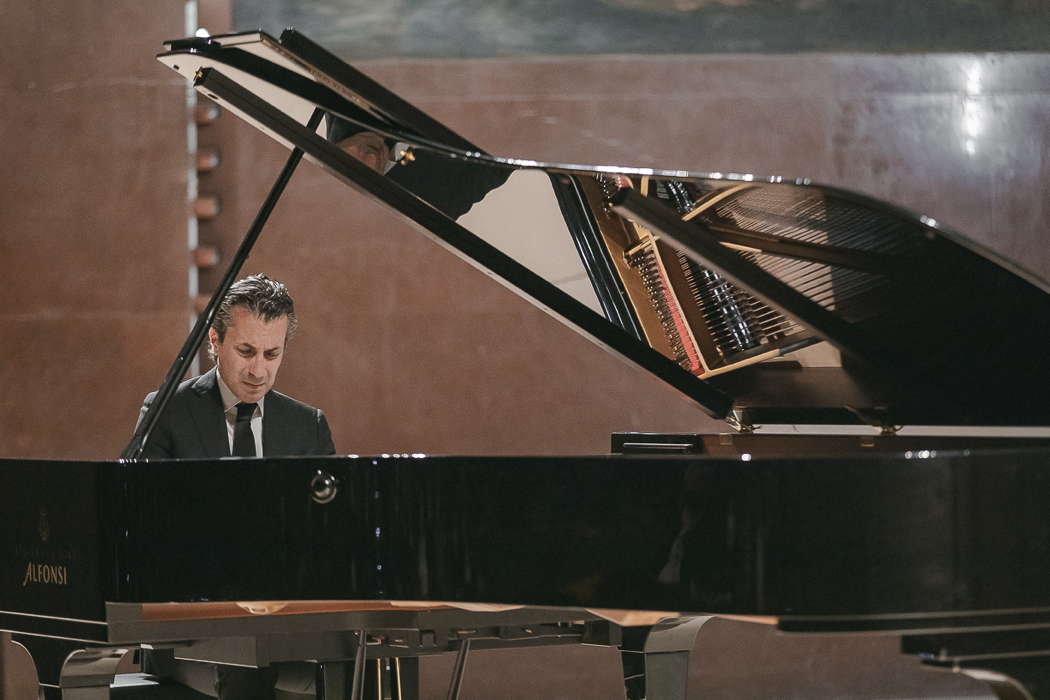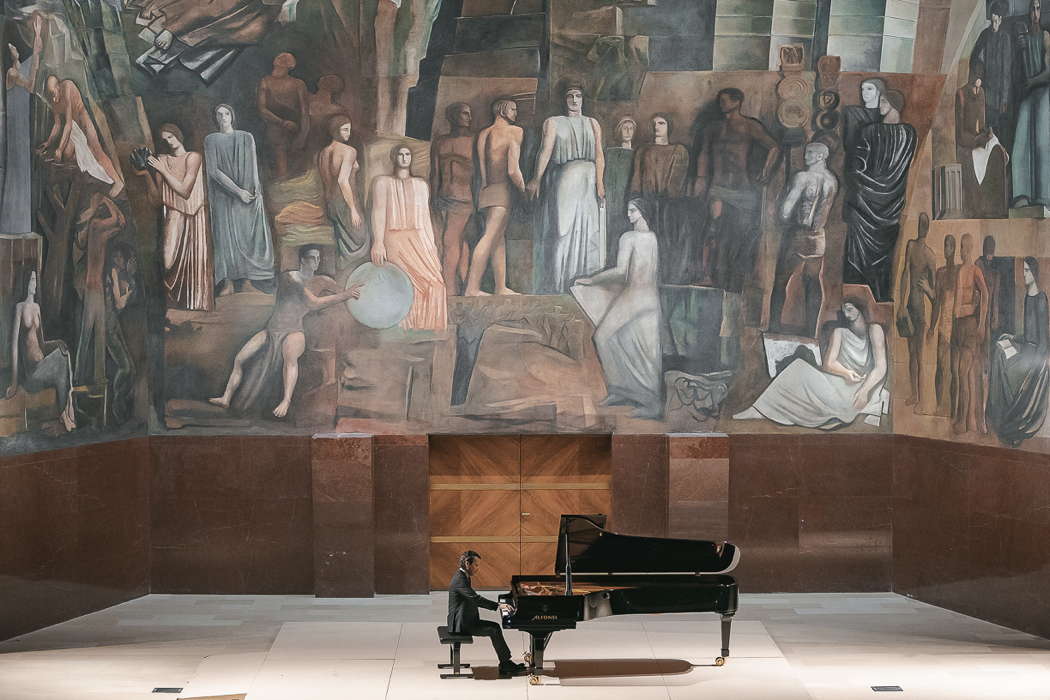- Vincent d'Indy
- Harvey Lavan Cliburn
- Anna Moffo
- Johan Svendsen
- Yaltah Menuhin
- Deutsche Grammophon
- KDFC
- Stewart Laing
 SPONSORED: An Outstanding Evening - Bill Newman listens to American pianist Rorianne Schrade.
SPONSORED: An Outstanding Evening - Bill Newman listens to American pianist Rorianne Schrade.
All sponsored features >>
 DISCUSSION: John Dante Prevedini leads a discussion about Composers, individuals or collective?, including contributions from David Arditti, Halida Dinova, Robert McCarney and Jane Stanley.
DISCUSSION: John Dante Prevedini leads a discussion about Composers, individuals or collective?, including contributions from David Arditti, Halida Dinova, Robert McCarney and Jane Stanley.
Absolute Ravel
GIUSEPPE PENNISI listens to music by Maurice Ravel played by Neapolitan pianist Roberto Cominati
A feature in the programming of Rome's University Institution of Concerts (IUC) is that of the 'integrals' or 'complete works'. This is a great classic of the IUC which boasts, in its annals, epochal events such as the complete Beethoven sonatas performed by Alfred Brendel and the piano works of Chopin played by Stanislav Bunin. The complete cycles are therefore an opportunity to immerse yourself in the world of a composer and follow his evolutionary paths. The 'complete books' of the madrigals by Carlo Gesualdo da Venosa have recently been reviewed in this magazine. Before the end of this 'season', it is scheduled the beginning of the 'integral' of the experimental music of Ennio Moricone, a little-known chapter of an author known above all for his film scores. On 7 May 2022, I was in the quite full concert hall to follow the second part of the 'integral' of the piano works of Maurice Ravel (1875-1937). The first part had been performed on 25 January 2022.
The solo pianist was Roberto Cominati. Appreciated 'for his stylistically impeccable and camouflaged pianism', Roberto Cominati won first prize at the 'Alfredo Casella' International Competition in Naples in 1991. In 1993, he came to the attention of critics and major international concert halls thanks to his winning first prize at the 'Ferruccio Busoni' Competition in Bolzano. In 1999, he was awarded the 'Jacques Stehman' audience prize of Belgian TV and French broadcaster TV5, as part of the 'Reine Elisabeth' competition in Brussels. Cominati has already recorded, in 2011, the complete piano music of Ravel on a box of two CDs for the Amadeus label.

Roberto Cominati playing Ravel at the Aula Magna della Sapienza in Rome on 7 May 2022. Photo © 2022 Andrea Caramelli
'Maurice Ravel's music has always been very important to me', Cominati tells me before the performance. 'I think it was decisive in the formation of my taste and my personality as an interpreter. It summarizes in itself the best qualities of the historical twentieth century, in an extraordinary synthesis that balances objectivity, seriousness, clarity and intelligence on the one hand, and fantasy, inventiveness, elegance and lightness on the other, in a constant and constantly fortunate search for perfection.'
The program of the concert followed Ravel's piano works chronologically. It started with early works such as the Menuet antique and Pavane per une infante défunte, which date back to the beginning of the twentieth century, and concludes with the well-known Le Tombeau de Couperin (composed during the First World War and considered by many to be his masterpiece and one of the very first expressions of twentieth-century neoclassicism). This is an intelligent choice. It makes the public listen to what many critics call 'the two souls' of Ravel. One is the formal classical and the other is late romantic introspective. They are, in fact, two aspects of a composer, apparently brilliant and such as to please the public (even salon), but substantially restless, aware of being at the turn of two very different centuries, indeed contrasting, with each other.
Of the three pieces in the first part, the most important is Gaspard de la nuit, also because it is technically very complex and performed only by great pianists. Inspired by a collection of poems by Aloysius Bertrand, it is divided into three episodes: Ondine, Lent (C sharp major), dedicated to Harold Bauer; Le gibet, Très lent (E flat minor), dedicated to Jean Marnold; and Scarbo, Modéré (B major), dedicated to Rudolph Ganz. The three poems chosen are perfect precisely for their echoes of tormented dream and mystery. Ondine represents a serene and clear dream like the light flow of water; Le gibet evokes the obsession with dark and gloomy hues; the third element Scarbo closes the series of dreamlike reminiscences with the figure of a deformed and ambivalent dwarf. This is not the place to dwell on the contents of the poems.
Ravel was aware that they were the pretext for the composition of a work of very difficult execution. Ravel, with a certain malice, explicitly stated that he had composed a work that surpassed in difficulty Balakirev's Islamey, unanimously considered one of the most difficult pieces ever written. On another occasion, Ravel judged his work with these words: 'I wanted to make a kind of caricature of Romanticism. I've probably achieved the best I can accomplish.' The technical mastery that Gaspard de la nuit requires of the performer is in fact absolute: the collection is still an arduous test, even for the most gifted pianists. Some particularly difficult passages require writing on three staves. Cominati offered a great performance.
In the second part, after the Menuet sur le nom d'Haydn, the Prélude and the two short pieces À la manière de Borodine and À la manière d'Emmanuel Chabrier, the central element was Le tombeau de Couperin. This is a suite, composed between 1914 and 1917; each movement is dedicated to a friend of the composer who died in the war. Subsequently, the suite was reworked for orchestra and some of its parts were used as ballet music. Cominati emphasized the liveliness and rhythm that pervades a composition in which the memory of a great Baroque composer - Couperin - is evoked and used as a memorial to seven great friends of Ravel.

Roberto Cominati playing Ravel at the Aula Magna della Sapienza in Rome on 7 May 2022. Photo © 2022 Andrea Caramelli
Ovations and requests for encores to which Cominati responded by offering transcriptions for piano of Boléro and Valses nobles et sentimentales.
Copyright © 9 May 2022
Giuseppe Pennisi,
Rome, Italy



